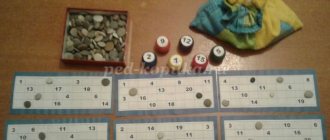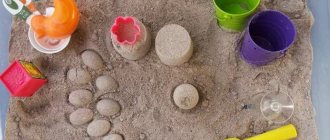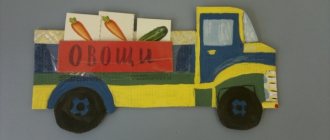Various methods of early development of children are popular among modern parents. But since the main activity for children is play, many of the systems are built accordingly, in particular, Montessori games. The author, Maria Montessori, offers not just a theoretical approach, but also specific options for educational fun for children aged 2-4 years. We invite you to get to know some of them.
Basic principles
We will not now dwell in detail on the essence of Maria Montessori’s early development system; a separate article is devoted to this topic, the text of which you can read here.
Let's briefly look at 5 fundamental principles:
- The main task of both the parent and the teacher is to ensure that the children themselves solve the tasks assigned to them. You can help, but only morally - with support and praise. The child must cope with the goal set before him on his own. In this case, he will gain self-confidence, independence, learn to overcome difficulties, and look for solutions.
- In the first place is taking into account the interests and desires of the child; nothing can be imposed on him; the baby does what he likes; the task of adults is to prepare the necessary developmental aids for him.
- Children should be directly involved in the education of younger children. To a greater extent, this principle is implemented in kindergarten groups.
- The main thing is to interest the baby, he will learn and develop himself.
- It is necessary to treat the child with respect, not criticize his actions, and recognize his right to make mistakes.
The motto of the system is “Help me do it myself,” and it is based on self-training and self-education.
Proper storage for toys
Very often, in children's rooms, all toys are stored in containers or deep toy baskets. In essence, this is a toy dump where it is almost impossible to find anything specific. Yes, a small child will never do this, he simply forgets about those toys that are lying at the bottom of the basket.
In a properly organized play space, all materials are arranged on racks and shelves. At the same time, all the shelves are located at the child’s level so that he can independently take any benefit that interests him. Each material has its own specific place here, which means the child always knows where to get what he needs and where to put it away later.
In Montessori development centers, the play space usually looks something like this:
However, it is very difficult to do something similar in an ordinary city apartment, because all these shelves require a lot of space, and you also need to put a closet somewhere and a bed... Therefore, at home you can make a more simplified version with fewer shelves . In addition, you do not need to post all the manuals at once, as in a development center; you can post a limited number of toys and rotate them regularly. This approach will not only save space in the room, but also help maintain the child’s interest in toys; they will not become boring. More on this below.
Thus, to organize a Montessori environment at home, one 2-3-tier rack is quite enough. It can be made to order or use ready-made solutions. We bought our rack at an Ikea store, this is what it looked like at 2 years old:
When such a shelving unit appeared in our nursery, it immediately became clear that this was a huge boon! I’m not talking about my daughter’s delight at all. Previously, frame inserts, knockers and other equipment were lying on the windowsill, where everyone always forgot about them, now everything was in plain sight, both for my daughter and for me. When Taisiya started playing, it was immediately clear what to tackle
There are several important points that you need to know in order to organize a competent Montessori environment in which your child will always be interested.
1. There shouldn’t be a lot of toys on the rack!
Firstly, a limited set of toys makes it easier for the child to choose and helps him concentrate on something specific. Secondly, if the shelves are chock full of developmental materials, then getting to any specific one becomes not so easy. Well, if a child experiences difficulties associated with pulling out and putting away the material, then with a high degree of probability he will prefer not to play with it at all.
2. It is necessary to constantly change the toys displayed on the rack.
When I first organized a shelving unit for my daughter, I was guided by the display of the development club - absolutely all the developmental materials available were laid out there. I wanted Taisiya to have a full selection of materials at home, so I pushed into the rack all the educational toys we had that were currently suitable for my daughter’s age. Some time passed before I realized that my daughter simply stopped noticing the toys that were constantly in the rack! They became so familiar to her that they seemed completely uninteresting.
Then I did what should have been done from the very beginning: I put all the toys in a closed cabinet, and put only a limited set of materials on the shelves so that each one was clearly visible. Every week I began to conduct a small audit: I removed from sight those toys in which there was no interest, and replaced them with others. And here the second life of our Montessori shelving began! Materials that no one had looked at before began to sparkle with new colors.
Regular rotation of toys is really very important, it helps to maintain the child's constant interest in developmental aids. It also allows you to get by with a small set of toys, since, disappearing from the child’s field of vision, they are soon perceived as a new thing.
Naturally, in order to meet the baby’s changing interests and promote his further development, completely new materials need to be displayed from time to time.
3. Toys should be at a height accessible to the child
(no higher than eye level), so that he can take from the shelf and put back any benefit that interests him without the help of an adult.
4. Each item on the rack should have its own place.
If possible, place toys so that they are visually separated from each other (at a short distance from each other).
5. The rack must be open.
Avoid anything that blocks the child’s view of the contents of the shelves: a large number of drawers, doors, etc.
Maria Montessori recommends distributing all materials into zones. In your shelving, you can also group games by meaning. For example, in one compartment you can always lay out insert frames, in another - cubes and construction sets, in the third - lacing, fasteners,
in the fourth - puzzles,
in the fifth - musical instruments, etc.
Despite the fact that Maria Montessori paid little attention to role-playing play, I am convinced that role-playing toys are also necessary on the shelf. For us, these sections have always been one of the most used.
The simplest games
There are many Montessori exercises and games. Let's look at the easiest options that you can play at home without any problems.
Comparison
Such fun will help to consolidate knowledge about colors in an easy and unobtrusive form. Here are the most useful exercises:
- Correlation. The child is given a circle divided into segments of different colors and a set of colored clothespins, the tones of which match the color of the circle fragments. The task is simple - “put” the clothespins into place (so that their color matches the color of the circle). An additional benefit is the development of fine motor skills.
- Socks. The child is given several socks, his goal is to sort them out in pairs.
The exercises are simple, sure to please the little one, and at the same time useful.
With water
These games are aimed at developing fine motor skills, as they involve working with small objects. Here are some of the most successful examples:
- Several objects should be placed in a basin of water, for example, mosaic elements, pebbles, shells, toys (the smallest ones available). The baby’s task is to take objects out of the container one at a time under the supervision of their parents. To prevent the baby from getting bored, it is better to come up with some interesting story, for example, that he helps an old fisherman get the necessary items from the bottom of the sea.
- The second option is to prepare soup for the queen. Water is poured into a plate at a comfortable temperature for the child, and grains of rice are dropped to the bottom. Using his fingers, the baby must take them out and put them in another container (from where the fairy-tale cook will take the grains and prepare a delicacy from them).
- It’s easy to ask your child to water flowers from a small watering can. This will accustom him to performing household duties and will help him learn new facts about representatives of the flora.
- Whipping foam with a whisk is a healthy pleasure. The child strengthens his hand and has fun.
These are the simplest exercises that require only a little water. The baby will have fun, have fun, and in addition, his individual skills will develop.
Child development up to one year according to Montessori: from 6 to 9 months
Around this age, the child begins to sit, which means he has much more opportunities to manipulate objects that must be used.
- Spinning drum
A toy from a classic Montessori set that perfectly develops a child’s discretion and coordination and teaches him to perform various actions with objects. To make the toy even more attractive, choose a model with a mirror in one of the sections. It is worth starting to offer such a toy when the baby can already hold himself in his arms, lying on his stomach and will be able to free one hand for play, and it will be at its peak at the moment when the child has learned to sit.
- Wooden rings on a stick
A very simple Montessori pyramid gives the child a huge field for experimentation: how to remove the rings from a stick and how to return them to their place, what will happen if you turn the pyramid over or throw it.
- Egg in a cup
A wooden egg in a cup also gives the child more knowledge about the interaction of objects. The egg can be taken out of the cup and returned to its place, and this is a whole discovery for the baby
- Simple inset puzzles
Wooden insert puzzles of the same shape become the first toys for logic. The baby will have to find its place for each insert, and then pull everything out of the grooves again. An excellent challenge for coordination and control of hand movements. Don’t expect that your baby will be able to select the right shapes already at this age; now it is important for the child to simply master grasping objects and learn to pull them out
- Musical toys
Rattles, tambourines, and bells on a stick are great for kids this age. Let your baby explore the sounds these objects make
- Baskets with items
Sets of animal figurines (with natural colors and proportions), a selection of kitchen utensils (whisk, beater, spoon). It is important for your baby to get acquainted with different shapes and textures, even if he does not understand the meaning of these objects yet, he will certainly enjoy turning them over with his hands.
By the end of this period, you can already begin Montessori classes “Together with Mom”
Fine motor games
Among the exercises in the Montessori system, a special place is occupied by those aimed at developing fine motor skills. Here are just a few examples:
- Stringing. You can use fishing line, laces, ropes as a base, and pasta, beads, and hair ties as elements for stringing. The main thing is to maintain interest, so you can invite your child to make a garland to decorate the room, make a necklace for an imaginary mermaid, or as a gift for grandma on her birthday.
- Exercises with forceps. You can invite your baby to use tongs or tweezers to sort some items, such as hair ties, by color. Or ask the child to place the pebbles in small boxes without touching them with his hands, using tweezers.
Sensory boxes
Another exercise from the Montessori system that will help develop fine motor skills. Preparing such boxes is not at all difficult: just take a flat box (of course, without sharp edges) and fill it with a bulk substance, for example, sand, semolina, buckwheat, other cereals, or even cotton wool.
Funnels, buckets, jars, spoons, and toy scoops are suitable equipment. The child’s task is to build a city or farm from loose substances and populate it with inhabitants – small toys. You can draw with your finger on the surface, build castles. Parents should not limit the baby, it is enough to observe from the side.
Games with tactile bags
They not only help develop motor skills, but are also aimed at improving the baby’s perception and introducing him to new sensations. It goes like this:
- First, parents prepare a visual aid - the bags themselves, which should feel different from each other. So, one must be made smooth, and the other must be made of rough material, one must be soft, the other must be hard.
- The next step is to introduce the child to these sensations.
- Finally, when he remembers everything, you can offer a game - place the tiny bags in one large (“magic bag”), after which the baby, without peeking, will have to take out the option that his mother asks for.
Montessori development method from 9 months to a year
By 9 months, the child learns to use his fingers and masters the accuracy of voluntary movements. In addition, babies are already moving around at full speed: crawling, trying to get up and even walk. At the same age, they begin to truly understand speech: they recognize words, understand spoken speech, and even chat in their own language.
- Box of Permanence
So we come to the most famous material using the Montessori method for children from 0 to 1 year old. The idea behind the Permanence Box is to teach your child that just because something is out of sight, it is not necessarily gone for good. After mastering the permanence box, you can move on to the wooden piggy bank. Its difference is that when it gets into the box, the coin does not immediately return to the child’s field of vision, but remains inside, which complicates the task for the baby: now you need to understand that the coin is in the box, even if you don’t see it. In addition, the coins themselves become more difficult objects for small fingers to grasp.
- Module for running figures
This Montessori module is similar to a box of permanence, but here the ball does not disappear, but rolls down from level to level. This toy may seem expensive, but children do not lose interest in them until they are three years old.
- Montessori inserts and sorters with different shapes
As children approach one year of age, they begin to recognize different shapes and can be offered the simplest inserts and sorters. Games can be accompanied by the words: “Look, this is a square, and this is a circle! Big blue circle!
- Wheels and trolleys
These toys will be useful for developing baby's walking skills. Children love to push wooden cars behind them, and carts and strollers will help them find their balance during their first awkward steps.
For children of different ages
Let's look at examples of exercises for kids of different ages according to the Montessori system.
From 1.5 years
There are special wooden blocks of various sizes that are widely popular in Montessori schools. With the Pink Tower set, children can build a small tower based on the matryoshka principle, developing their sensory experience.
From 2 to 3 years
For children of this age, you can purchase a special Montessori set of objects that vary in size, color, and shape. The baby’s task is to sort, and moms and dads don’t have to demand that he sort objects by color or shape. It is better to give the child freedom of action; he will figure out the comparison parameters himself and identify common features and differences.
If it is not possible to purchase an expensive manual, it is easy to make a similar set yourself. Buttons of various colors and sizes are suitable for this.
Pyramid
The baby is offered the base of the toy and a row of rings. His task is to find among them those of the same type (for example, the same color) and create a design.
From 3 to 4 years
A suitable option for this age are wooden puzzles, which depict a simple and familiar object to the child. You should not chase a large number of elements; it is very important to take into account the individual characteristics of the baby: for some, only 3-4 components will be enough, while others will easily assemble a structure from 5-6 fragments. The most important thing is to optimally choose the level of difficulty so that the child does not get bored, but also does not lose faith in himself.
Multi-colored signs
Another exercise widely used in Montessori schools. It is a ready-made set of wooden signs painted in various colors. You can either make them yourself or purchase them. With the help of such a manual, you can teach children to distinguish shades, as well as consolidate previously acquired knowledge about colors.
The child’s task is not just to combine pairs that match in color and shade, but also to name them correctly. At 3–4 years old, you can offer your baby not only basic tones, but also less popular ones, in particular, purple, pink, orange, and brown.
Game options:
- Arrange the signs in gradations from dark to light or vice versa.
- Find among the signs the one whose color is closest to any object in the room’s furnishings (for example, the lamp shade is red - the child looks for and shows the red sign, you can attach it to the lamp, compare and make sure that the problem is solved correctly).
- The parent shows any sign, and the child must find among the remaining ones the one that is darker or, on the contrary, lighter than the one demonstrated.
All this will help you remember colors and understand what “darker” and “lighter” are.
At 4–5 years old
For kids of this age, the “Basket with scraps”, in which pieces of various fabrics are placed, will be an excellent educational activity:
- wool;
- cotton;
- linen;
- nylon;
- silk and others.
There should be two of each fragment. The child’s task is to find a pair, that is, two identical pieces, solely by touch, without looking.
Parents do not need to be prompted - if the child makes a mistake, then when he completes the task and opens his eyes, he will be able to see what’s wrong and quickly figure it out.
With sandpaper
To complete this exercise, you will need a set that includes 12 small boards, divided into 6 pairs. Each of them contains sandpaper of different grits. The child, like last time, closes his eyes and acts only tactilely. The task is simple - arrange 12 planks into 6 pairs, this is quite possible, since the surface varies.
Other toys
Modern manufacturers take advantage of the fact that early development systems are in great demand. That is why there are so many different toys on the market, beautiful, bright, but are all of them useful? Consider the options that can be purchased for Montessori games:
- Sorter. It is a set of elements of various shapes and sizes (as a rule, these are geometric shapes, although other options are acceptable), as well as a special sheet with holes into which these elements are inserted. The child's task is simple - to match the figurine and the hole for it. If desired, you can make a sorter yourself. It is one of the most useful toys for the development of fine motor skills and thinking.
- Framework. Very similar to the previously described sorter. They are a flat frame with holes and figures that match these holes in shape and size. During the game, the child will have to match the figure and the “cutout” in the frame for it. When deciding what is worth buying for your baby, you can choose this one.
- Laces. A wonderful tool for developing fine motor skills and training household skills. Of course, you can buy a store-bought version, a beautiful and bright toy that your little one will love. But it’s not difficult to make one yourself, from thick cardboard, in which holes are cut, and ordinary lace.
- Cups. A set of colored molds that fit into each other like a nesting doll is also a wonderful educational toy. Suitable for babies from one year old. There are many options, differing in the number of elements and cost.
How to make toys yourself according to Montessori principles is described here.
When offering Montessori games to your child, you should not be overzealous, since, often in pursuit of early development, parents deprive their child of childhood. Not everyone succeeds in raising a young genius or erudite, but with the right approach, even the simplest manual, made independently, will be beneficial.
Attention game (3–5 years)
This game (also called memory) will help your child develop visual memory and recognition skills. You can buy it in a store or make it yourself. You need to cut out 16 cards the size of a standard playing card from thin cardboard. Draw or cut out two identical sets of 8 different geometric shapes. You can use pictures of animals. Glue a geometric shape or picture onto each card. As a result, you should have a set of 16 cards of the same size, consisting of 8 pairs with different geometric shapes or pictures.
To start the game, shuffle the cards and place them face down in a square shape. The first player turns over 2 cards at the same time. If the pictures on them match, the player takes both for himself. If not, the player turns them face down. Everyone tries to remember where each card is located so that on the next move they can turn over the matching cards. The game continues until all the cards match.
When the child masters the game, you can change sets of cards and complicate the task by adding additional pairs of cards and not laying them out in rows.






